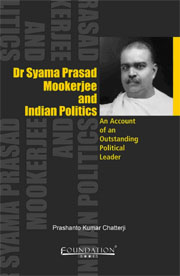Book contents
- Frontmatter
- Contents
- Preface
- 1 Dr Syama Prasad Mookerjee as the Finance Minister of Bengal, 1941–1942
- 2 Syama Prasad and Hindu Mahasabha's Ascendancy in Indian Politics, 1938–1944
- 3 Syama Prasad and Hindu Mahasabha's Transitory Resuscitation after Reverses, 1945–1947
- 4 Syama Prasad's Achievements as the Central Cabinet Minister, 1947–1950
- 5 Syama Prasad and Establishment of Bharatiya Jana Sangh, 1950–1953
- 6 Conclusion
- Appendix I
- Appendix II
- Appendix III
- Appendix IV
- Appendix V
- Appendix VI
- Appendix VII
- Bibliography
- Index
5 - Syama Prasad and Establishment of Bharatiya Jana Sangh, 1950–1953
Published online by Cambridge University Press: 05 February 2012
- Frontmatter
- Contents
- Preface
- 1 Dr Syama Prasad Mookerjee as the Finance Minister of Bengal, 1941–1942
- 2 Syama Prasad and Hindu Mahasabha's Ascendancy in Indian Politics, 1938–1944
- 3 Syama Prasad and Hindu Mahasabha's Transitory Resuscitation after Reverses, 1945–1947
- 4 Syama Prasad's Achievements as the Central Cabinet Minister, 1947–1950
- 5 Syama Prasad and Establishment of Bharatiya Jana Sangh, 1950–1953
- 6 Conclusion
- Appendix I
- Appendix II
- Appendix III
- Appendix IV
- Appendix V
- Appendix VI
- Appendix VII
- Bibliography
- Index
Summary
SECTION-1: Dr Mookerjee's Quest for a Political Platform
Dr Mookerjee's resignation created a stir in the country. The Congress circles felt uneasy and the press they controlled tried to minimise the importance of the event. But the people hailed it as a brave act. The citizens of Delhi demonstrated their appreciation for Dr Mookerjee's stand by hosting a grand reception to congratulate him on his bold decision which was attended by more than a thousand representative citizens drawn from all walks of life. Some of the independent-minded Congressmen like H.V. Kamath, Member of Parliament, also hailed his exit from the Cabinet as the beginning of a healthy opposition within the Parliament. But the tragedy of the situation was that no organised opposition then existed within or without Parliament, which was also the Constituent Assembly and was elected indirectly by the Provincial Legislature in 1946 when the main problem before the country was the demand for partition of the country. The Congress then captured all the Hindu seats by presenting itself as the champion of united India, while Muslims, returned by the Muslim League, constituted the main opposition for some time. The Partition converted the Muslim League opposition into the sovereign Parliament of Pakistan. So in the parliamentary debates, the role of opposition had to be played by a few outspoken Congressmen and liberals like Pandit Hriday Nath Kunzru who, however, all belonged to the Congress party for voting purposes.
- Type
- Chapter
- Information
- Dr Syama Prasad Mookerjee and Indian PoliticsAn Account of an Outstanding Political Leader, pp. 267 - 331Publisher: Foundation BooksPrint publication year: 2010

